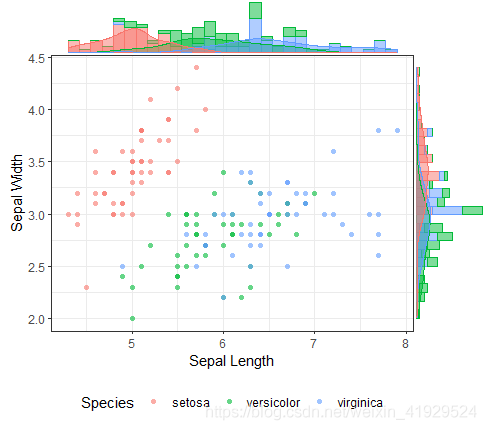这篇文章主要为大家展示了“如何使用R语言绘制散点图结合边际分布图”,内容简而易懂,条理清晰,希望能够帮助大家解决疑惑,下面让小编带领大家一起研究并学习一下“如何使用R语言绘制散点图结合边际分布图”这篇文章吧。
主要使用ggExtra结合ggplot2两个R包进行绘制。(胜在简洁方便)使用cowplot与ggpubr进行绘制。(胜在灵活且美观)
下面的绘图我们均以iris数据集为例。
1. 使用ggExtra结合ggplot2
1)传统散点图
# librarylibrary(ggplot2)library(ggExtra)# classic plotp <- ggplot(iris) + geom_point(aes(x = Sepal.Length, y = Sepal.Width, color = Species), alpha = 0.6, shape = 16) + # alpha 调整点的透明度;shape 调整点的形状 theme_bw() + theme(legend.position = "bottom") + # 图例置于底部 labs(x = "Sepal Length", y = "Sepal Width") # 添加x,y轴的名称p
下面我们一行代码添加边际分布(分别以密度曲线与直方图的形式来展现):
2)密度函数
# marginal plot: densityggMarginal(p, type = "density", groupColour = TRUE, groupFill = TRUE)
3)直方图
# marginal plot: histogramggMarginal(p, type = "histogram", groupColour = TRUE, groupFill = TRUE)
4)箱线图(宽窄的显示会有些问题)
# marginal plot: boxplotggMarginal(p, type = "boxplot", groupColour = TRUE, groupFill = TRUE)
5)小提琴图(会有重叠,不建议使用)
# marginal plot: violinggMarginal(p, type = "violin", groupColour = TRUE, groupFill = TRUE)
6)密度函数与直方图同时展现
# marginal plot: densigramggMarginal(p, type = "densigram", groupColour = TRUE, groupFill = TRUE)
2. 使用cowplot与ggpubr
1)重绘另一种散点图
# Scatter plot colored by groups ("Species")sp <- ggscatter(iris, x = "Sepal.Length", y = "Sepal.Width", color = "Species", palette = "jco", size = 3, alpha = 0.6) + border() + theme(legend.position = "bottom")sp
2)有缝拼接
① 密度函数
library(cowplot)# Marginal density plot of x (top panel) and y (right panel)xplot <- ggdensity(iris, "Sepal.Length", fill = "Species", palette = "jco")yplot <- ggdensity(iris, "Sepal.Width", fill = "Species", palette = "jco") + rotate()# Cleaning the plotssp <- sp + rremove("legend")yplot <- yplot + clean_theme() + rremove("legend")xplot <- xplot + clean_theme() + rremove("legend")# Arranging the plot using cowplotplot_grid(xplot, NULL, sp, yplot, ncol = 2, align = "hv", rel_widths = c(2, 1), rel_heights = c(1, 2))
② 未被压缩的箱线图
# Marginal boxplot of x (top panel) and y (right panel)xplot <- ggboxplot(iris, x = "Species", y = "Sepal.Length", color = "Species", fill = "Species", palette = "jco", alpha = 0.5, ggtheme = theme_bw())+ rotate()yplot <- ggboxplot(iris, x = "Species", y = "Sepal.Width", color = "Species", fill = "Species", palette = "jco", alpha = 0.5, ggtheme = theme_bw())# Cleaning the plotssp <- sp + rremove("legend")yplot <- yplot + clean_theme() + rremove("legend")xplot <- xplot + clean_theme() + rremove("legend")# Arranging the plot using cowplotplot_grid(xplot, NULL, sp, yplot, ncol = 2, align = "hv", rel_widths = c(2, 1), rel_heights = c(1, 2))
3)无缝拼接
# Main plotpmain <- ggplot(iris, aes(x = Sepal.Length, y = Sepal.Width, color = Species)) + geom_point() + color_palette("jco")# Marginal densities along x axisxdens <- axis_canvas(pmain, axis = "x") + geom_density(data = iris, aes(x = Sepal.Length, fill = Species), alpha = 0.7, size = 0.2) + fill_palette("jco")# Marginal densities along y axis# Need to set coord_flip = TRUE, if you plan to use coord_flip()ydens <- axis_canvas(pmain, axis = "y", coord_flip = TRUE) + geom_density(data = iris, aes(x = Sepal.Width, fill = Species), alpha = 0.7, size = 0.2) + coord_flip() + fill_palette("jco")p1 <- insert_xaxis_grob(pmain, xdens, grid::unit(.2, "null"), position = "top")p2 <- insert_yaxis_grob(p1, ydens, grid::unit(.2, "null"), position = "right")ggdraw(p2)
以上是“如何使用R语言绘制散点图结合边际分布图”这篇文章的所有内容,感谢各位的阅读!相信大家都有了一定的了解,希望分享的内容对大家有所帮助,如果还想学习更多知识,欢迎关注编程网行业资讯频道!




